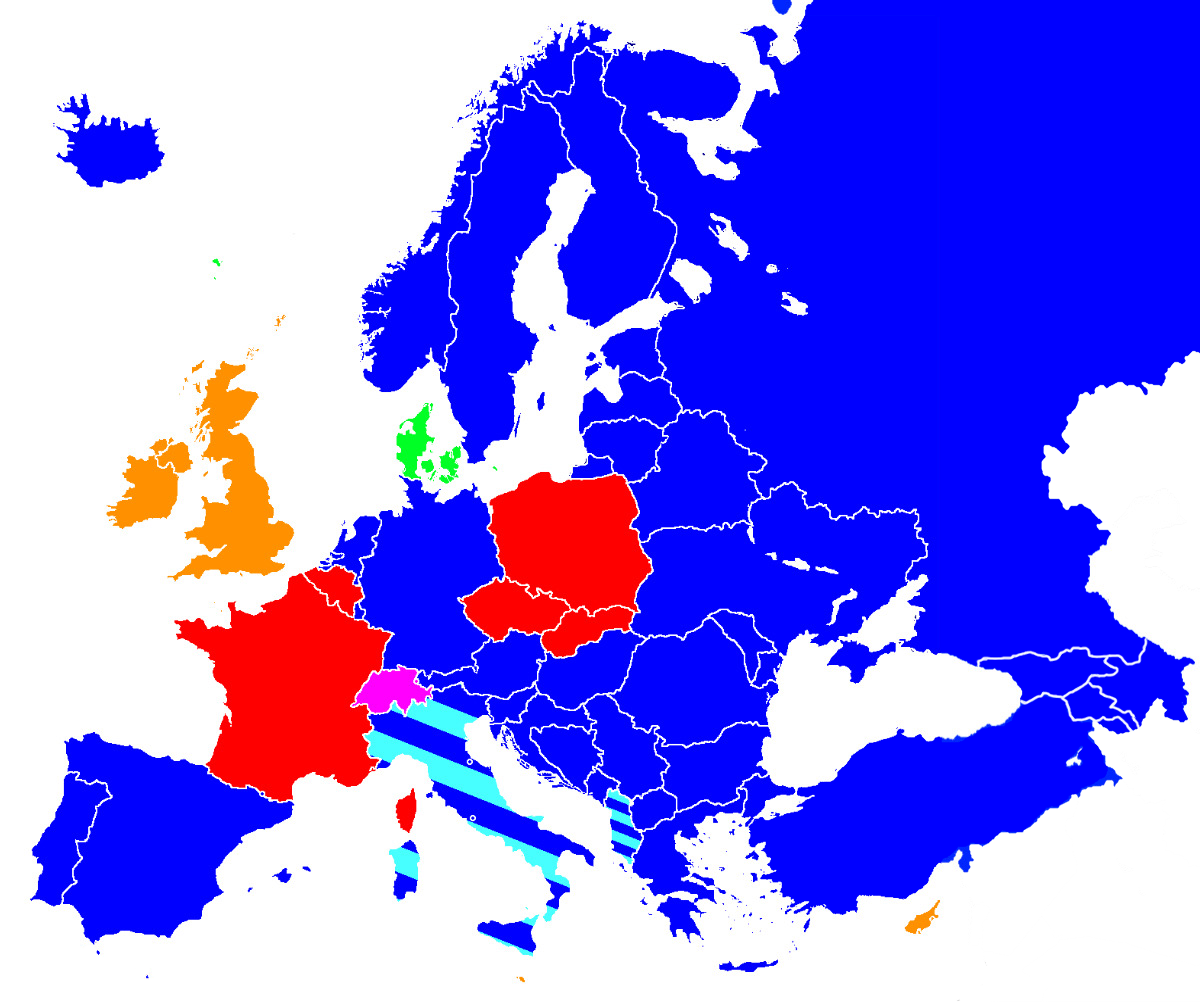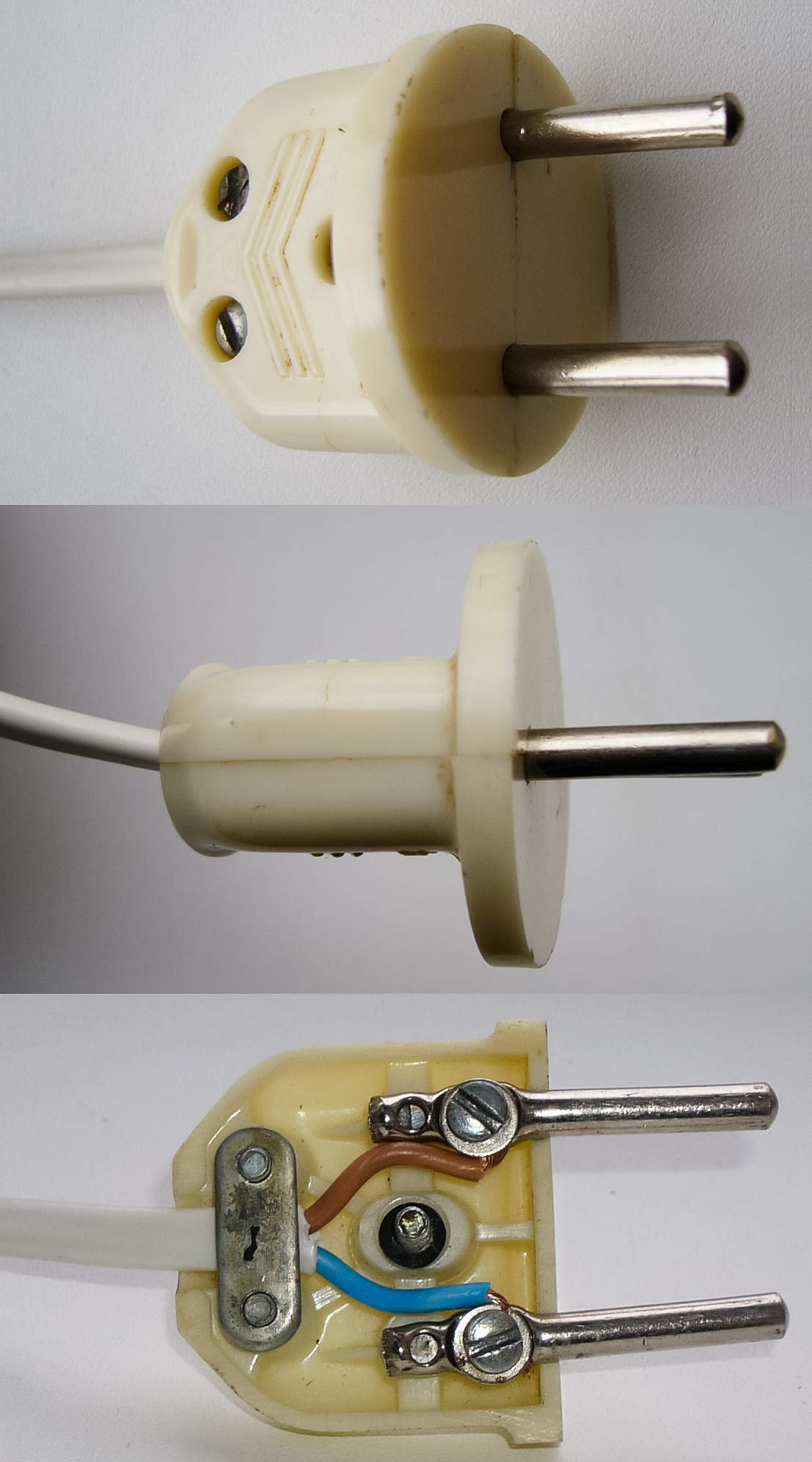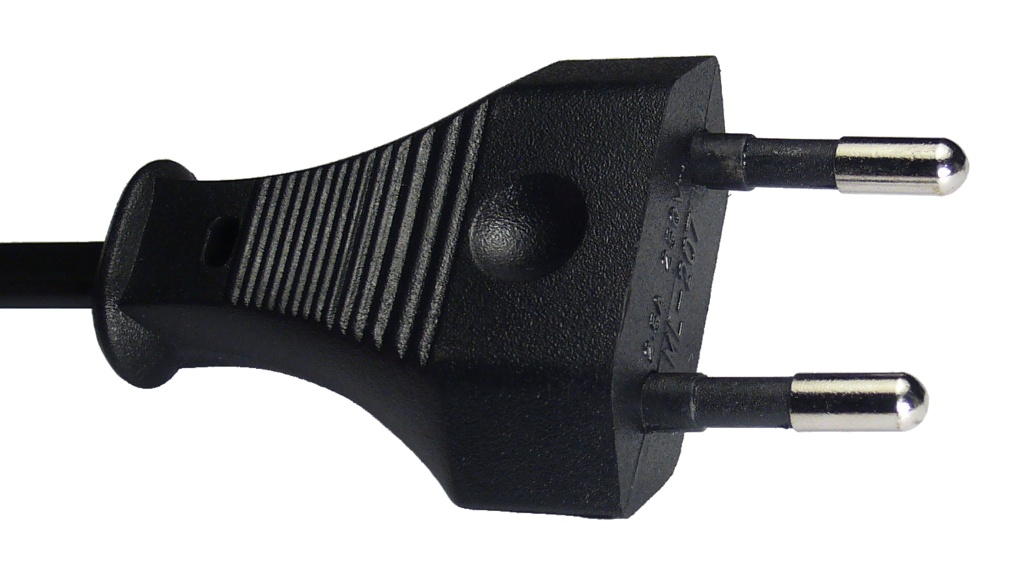|
Schuko
"Schuko" () is a registered trademark referring to a system of AC power plugs and sockets that is defined as " CEE 7/3" (sockets) and "CEE 7/4" (plugs). A Schuko plug features two round pins of 4.8 mm diameter (19 mm long, centers 19 mm apart) for the line and neutral contacts, plus two flat contact areas on the top and bottom side of the plug for protective earth ( ground). The socket (which is often, in error, also referred to as CEE 7/4) has a predominantly circular recess which is 17.5 mm deep with two symmetrical round apertures and two earthing clips on the sides of the socket positioned to ensure that the earth is always engaged before live pin contact is made. Schuko plugs and sockets are symmetric AC connectors. They can be mated in two ways, therefore line can be connected to either pin of the appliance plug. As with most types of European sockets, Schuko sockets can accept Europlugs. Schuko plugs are considered a very safe design when used with ... [...More Info...] [...Related Items...] OR: [Wikipedia] [Google] [Baidu] |
CEI 23-50
AC power plugs and sockets connect electric equipment to the alternating current (AC) mains electricity power supply in buildings and at other sites. Electrical plugs and sockets differ from one another in voltage and electric current, current rating, shape, size, and connector type. Different standard systems of plugs and sockets are used around the world. Plugs and sockets for portable appliances became available in the 1880s, to replace connections to light sockets with wall-mounted outlets. A proliferation of types developed for both convenience and protection from electrical injury. Today there are about 20 types in common use around the world, and many obsolete socket types are found in older buildings. Coordination of technical standards has allowed some types of plug to be used across large regions to facilitate trade in electrical appliances, and for the convenience of travellers and consumers of imported electrical goods. Some multi-standard sockets allow use of seve ... [...More Info...] [...Related Items...] OR: [Wikipedia] [Google] [Baidu] |
AC Power Plugs And Sockets
AC power plugs and sockets connect electric equipment to the alternating current (AC) mains electricity power supply in buildings and at other sites. Electrical plugs and sockets differ from one another in voltage and current rating, shape, size, and connector type. Different standard systems of plugs and sockets are used around the world. Plugs and sockets for portable appliances became available in the 1880s, to replace connections to light sockets with wall-mounted outlets. A proliferation of types developed for both convenience and protection from electrical injury. Today there are about 20 types in common use around the world, and many obsolete socket types are found in older buildings. Coordination of technical standards has allowed some types of plug to be used across large regions to facilitate trade in electrical appliances, and for the convenience of travellers and consumers of imported electrical goods. Some multi-standard sockets allow use of several types of pl ... [...More Info...] [...Related Items...] OR: [Wikipedia] [Google] [Baidu] |
IEC 60906-1
IEC 60906-1 is an international standard designed ''"to provide a standard for a safe, compact and practical 16 A 250 V AC system of plugs and socket-outlets that could be accepted by many countries as their national standard, even if not in the near future."'' The standard was originally published by the International Electrotechnical Commission in 1986; the current edition is ed2.0 published in 2009. Although it is almost identical to the Swiss SEV 1011 T12 plug for 10 A 250 V a.c. standardised in 1937, its dimensions are slightly different and its polarization is flipped (if the socket has the protective/earth conductor at the bottom, the phase is located left and neutral right). As of July 2014, only South Africa has introduced a standard (SANS 164-2) based closely on IEC 60906-1. Brazil used it as the basis for its NBR 14136 standard, but this is not compatible with IEC 60906-1. In 2017 the European Union (EU) published recommendations advising ... [...More Info...] [...Related Items...] OR: [Wikipedia] [Google] [Baidu] |
GOST 7396
GOST 7396 (''ГОСТ 7396'' in Cyrillic) is a series of Soviet and later Russian standards that specify basic dimensions and safety requirements for power plugs and sockets used in Russia and other former Soviet Republics, as well as for export to markets that use American or British plugs. Many official standards in Eastern Europe are virtually identical to the Schuko standard. One of the protocols governing the reunification of Germany required that the DIN and VDE standards would prevail without exception, so the former East Germany had to conform to the Schuko standard. Most other Eastern European countries use the Schuko standard internally but, prior to its collapse, they exported large volumes of appliances to the Soviet Union with the Soviet standard plug installed. Because of that, many of the Russian plugs found their way into other Eastern European countries. One peculiarity of the Soviet standard is the use of an ungrounded plug with 4.0 mm diameter pins for 6&nbs ... [...More Info...] [...Related Items...] OR: [Wikipedia] [Google] [Baidu] |
Europlug
The Europlug is a flat, two-pole, round-pin domestic AC power plug, rated for voltages up to 250 V and currents up to 2.5 A.European Standard EN 50075: Flat non-wirable two-pole plugs, 2.5 A 250 V, with cord, for the connection of class II-equipment for household and similar purposes , Brussels, 1990. It is a compromise design intended to connect low-power Class II appliances safely to the many different ... [...More Info...] [...Related Items...] OR: [Wikipedia] [Google] [Baidu] |
Verband Der Elektrotechnik, Elektronik Und Informationstechnik
The VDE e. V. (german: Verband der Elektrotechnik, Elektronik und Informationstechnik) is one of Europe’s largest technical-scientific associations with 36,000 members, including 1,300 corporate and institutional members and 8,000 students. The Association Organization With 36,000 members (including 1,300 companies) the VDE Association for Electrical, Electronic & Information Technologies is one of the largest technical and scientific associations in Europe. VDE embraces science, standardization work and product testing and certification under one roof. VDE is involved in technical knowledge transfers, research and promoting young talents in the technologies of electrical engineering, electronics and information technology and their applications. Other VDE activities include ensuring safety in electrical engineering, developing recognized technical regulations as national and international standards as well as testing and certifying electrical and electronic devices and sy ... [...More Info...] [...Related Items...] OR: [Wikipedia] [Google] [Baidu] |
CEE 7-7
Cee or CEE may refer to: * C, third letter of the Latin alphabet * Cee, Spain, A Coruña, Galicia * Center for Excellence in Education, US * Central and Eastern Europe * Centre for Environment Education * Centre for the Economics of Education, London, England * ', now IECEE, an electrical standards body ** CEE 7 standard AC plugs and sockets ** CEE 17 IEC 60309 (formerly IEC 309 and CEE 17, also published by CENELEC as EN 60309) is a series of international standards from the International Electrotechnical Commission (IEC) for "plugs, socket-outlets and couplers for industrial purpo ..., now IEC 60309, connector standard * ', French abbreviation for European Economic Community * Conjugated equine estrogens, a medication * Consortium for Energy Efficiency, North America * Converged Enhanced Ethernet {{disambiguation ... [...More Info...] [...Related Items...] OR: [Wikipedia] [Google] [Baidu] |
Alsace
Alsace (, ; ; Low Alemannic German/ gsw-FR, Elsàss ; german: Elsass ; la, Alsatia) is a cultural region and a territorial collectivity in eastern France, on the west bank of the upper Rhine next to Germany and Switzerland. In 2020, it had a population of 1,898,533. Alsatian culture is characterized by a blend of Germanic and French influences. Until 1871, Alsace included the area now known as the Territoire de Belfort, which formed its southernmost part. From 1982 to 2016, Alsace was the smallest administrative '' région'' in metropolitan France, consisting of the Bas-Rhin and Haut-Rhin departments. Territorial reform passed by the French Parliament in 2014 resulted in the merger of the Alsace administrative region with Champagne-Ardenne and Lorraine to form Grand Est. On 1 January 2021, the departments of Bas-Rhin and Haut-Rhin merged into the new European Collectivity of Alsace but remained part of the region Grand Est. Alsatian is an Alemannic dialect close ... [...More Info...] [...Related Items...] OR: [Wikipedia] [Google] [Baidu] |
South Tyrol
it, Provincia Autonoma di Bolzano – Alto Adige lld, Provinzia Autonoma de Balsan/Bulsan – Südtirol , settlement_type = Autonomous province , image_skyline = , image_alt = , image_caption = , image_flag = Flag_of_South_Tyrol.svg , flag_alt = , image_shield = Suedtirol CoA.svg , shield_size = x100px , shield_alt = Coat of arms of Tyrol , anthem = , image_map = Bolzano in Italy.svg , map_alt = , map_caption = Map highlighting the location of the province of South Tyrol in Italy (in red) , coordinates = , coordinates_footnotes = , subdivision_type = Country , subdivision_name = Italy , subdivision_type1 = ... [...More Info...] [...Related Items...] OR: [Wikipedia] [Google] [Baidu] |






